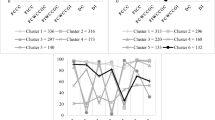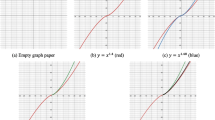Abstract
Research study on students’ conceptions of irrational numbers before entering university is of importance in order that the construction of the real number field introduced at the university level will have the desired effect. The aim of the present study is to analyze the way students approach the question of the existence of irrational numbers. 91 10th graders and 97 11th and 12th graders participated in the research study. The analysis focuses first on students’ conceptions of irrational numbers by using their representation as non-repeating infinite decimals. Then, the analysis focuses on students’ conceptions of irrational numbers on the number line. In spite of the fact that around 80% of the students claimed that they had learned about irrational numbers, only a small percentage of students (19%) showed awareness of the existence of irrational numbers as non-repeating infinite decimals. The same percentage of students (20%) showed awareness of the existence of irrational numbers on the real number line. I also observe some students’ answers that expressed their awareness of the existence of irrational numbers as non-repeating infinite decimals but the same students wrote that there are only rational numbers on the number line. Analyzing students’ conceptions of irrational numbers using both representations, as non-repeating infinite decimals and as points on the number line, I observe the incoherence of some of their conceptions.
Résumé
La recherche sur les conceptions que les étudiants ont des nombres irrationnels avant leur entrée à l’université est. importante afin que la construction du champ de nombres réels introduite au niveau universitaire soit faite de façon appropriée. Le but de la présente étude est. d’analyser comment les élèves abordent la question de l’existence de nombres irrationnels. 91 élèves de seconde et 97 élèves de premières et terminales ont participé à la recherche. Dans cet article, le focus de l’analyse est. d’abord sur les conceptions des étudiants des nombres irrationnels à l’aide de leur représentation décimale infinie sans répétition. Ensuite, le focus de l’analyse est. sur les conceptions des nombres irrationnels sur la droite réelle par les élèves. Bien qu’environ 80% des étudiants ont déclaré qu’ils avaient appris le concept de nombres irrationnels, seul un faible pourcentage d’étudiants (19%) ont démontré qu’ils étaient conscients de l’existence de nombres avec représentation décimale infinie sans répétition. Le même pourcentage d’étudiants (20%) sont conscients de l’existence des nombres irrationnels sur la droite réelle. J’ai également observé des réponses de certains étudiants qui reconnaissent l’existence de nombres irrationnels avec représentation décimale infinie sans répétition, mais les mêmes étudiants ont écrit qu’il existe seulement des nombres rationnels sur la droite réelle. En analysant les conceptions des nombres irrationnels par les élèves en utilisant les deux représentations: représentation décimale infinie sans répétition et des points de la droite réelle j’ai observé l’incohérence de certaines de leurs conceptions.



Similar content being viewed by others
References
Artigue, M. (2001). What can we learn from educational research at the university level? In D. Holton (Ed.), The teaching and learning of mathematics at university level (pp. 207–220). Netherlands: Springer.
Barbé, J., Bosch, M., Espinoza, L., & Gascón, J. (2005). Didactic restrictions on the teacher's practice: The case of limits of functions in Spanish high schools. Educational Studies in Mathematics, 59, 235–268.
Bronner, A. (1997). Les rapports d’enseignants de troisième et de seconde aux objets "nombre réel" et "racine carrée". Recherches en Didactique des Mathématiques, 17(3), 55–80.
Durand-Guerrier, V., & Tanguay, D. (2016). Introduire les réels à la transition lycée-université: Questions épistémologiques et horizon didactique. In E. Nardi, C. Winsløw, & T. Hausberger (Eds.), Proceedings of the first conference of the international network for didactic research in university mathematics (INDRUM) (pp. 177–179). Montpellier, France: University of Montpellier and INDRUM.
Fischbein, E. (1987). Intuition in science and mathematics: An educational approach. Dordrecht: Reidel.
Fischbein, E. (2001). Tacit models and infinity. Educational Studies in Mathematics, 48, 309–329.
Fischbein, E., Tirosh, D., & Hess, P. (1979). The intuition of infinity. Educational Studies in Mathematics, 10(1), 3–40.
Fischbein, E., Jehiam, R., & Cohen, C. (1995). The concept of irrational number in highschool students and prospective teachers. Educational Studies in Mathematics, 29, 29–44.
González-Martín, A. S., Giraldo, V., & Souto, A. M. (2013). The introduction of real numbers in secondary education: An institutional analysis of textbooks. Research in Mathematics Education, 15(3), 230–248.
González-Martín, A. S., Bloch, I., Durand-Guerrier, V., & Maschietto, M. (2014). Didactic situations and didactical engineering in university mathematics: Cases from the study of calculus and proof. Research in Mathematics Education, 16(2), 117–134.
Kidron, I. (1985). High school students’ perceptions of rational and irrational numbers. Unpublished master of science thesis. Hebrew University, Jerusalem, Israel.
Kidron, I., & Tall, D. (2015). The roles of visualization and symbolism in the potential and actual infinity of the limit process. Educational Studies in Mathematics, 88(2), 183–199 Springer.
Kidron, I., & Vinner, S. (1983). Rational numbers and decimals at the senior high level: Density and comparison. In R. Hershkowitz (Ed.), Proceedings of the 7th conference of the International Group for the Psychology of mathematics education (pp. 301–306). Rehovot: Weizmann.
Monaghan, J. (1986). Adolescent’s understanding of limits and infinity. Unpublished Ph. D. thesis, Warwick University, U.K.
Sirotic, N., & Zazkis, A. (2007a). Irrational numbers: The gap between formal and intuitive knowledge. Educational Studies in Mathematics, 65(1), 49–76.
Sirotic, N., & Zazkis, R. (2007b). Irrational numbers on a number line - where are they? International Journal of Mathematical Education in Science and Technology, 38(4), 477–488.
Smith, D.E. (1959). A source book in Mathematics, Volume 1. (pp. 35–45). New York: Dover.
Tall, D. (2013). How humans learn to think mathematically. Exploring the three worlds of mathematics. New York: Cambridge University Press.
Vinner, S., & Kidron, I. (1985). The concept of repeating and non repeating decimals at the senior high level. In L. Streefland (Ed.), Proceedings of the 9th conference of the International Group for the Psychology of mathematics education (Vol. 1, pp. 357–361). Utrecht: State University.
Zazkis, R., & Sirotic, N. (2004). Making sense of irrational numbers: Focusing on representation. In M. J. Hoines & A. B. Fuglestad (Eds.), Proceedings of 28th international conference for psychology of mathematics education (Vol. 4, pp. 497–505). Bergen: Bergen University College.
Zazkis, R., & Sirotic, N. (2010). Representing and defining irrational numbers: Exposing the missing link. Research in Collegiate Mathematics Education, 7, 1–27.
Acknowledgments
I would like to thank Shlomo Vinner for his substantial contribution to this research. This research was supported by the Israel Science Foundation (grant number 1815/16).
Author information
Authors and Affiliations
Corresponding author
Rights and permissions
About this article
Cite this article
Kidron, I. Students’ Conceptions of Irrational Numbers. Int. J. Res. Undergrad. Math. Ed. 4, 94–118 (2018). https://doi.org/10.1007/s40753-018-0071-z
Published:
Issue Date:
DOI: https://doi.org/10.1007/s40753-018-0071-z
Keywords
- Extension of rational numbers to irrational numbers
- Existence of irrational numbers
- Intuition
- Non-repeating infinite decimal
- Real number line




